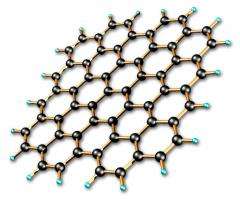May 18, 2010 feature
Looking for critical behavior in graphene

(PhysOrg.com) -- "One of the hopes people have for graphene is in electronic devices. It is seen as a possible replacement for silicon, due to its unique properties," Herb Fertig tells PhysOrg.com. Graphene conducts well, and it is easy to cool, making it ideal for use in electronic devices continually shrinking in size. However, scientists have yet to understand some of the properties of graphene, including how to control the flow of electrons. "In silicon," Fertig continues, "there is an energy gap that can be exploited to manipulate the flow of electrons. Graphene is a good conductor, but it is less clear how to control the electrons."
In an effort to better understand some of the properties of graphene, Fertig, a professor at Indiana University, worked with Jianhui Wang, a student at Indiana University, and Professor Ganpathy Murthy at the University of Kentucky, to develop an analytical calculation that could shed some light on the way that graphene behaves. Their work appears in Physical Review Letters: “Critical Behavior in Graphene with Coulomb Interactions.”
“During phase transitions in most systems there is a point known as criticality, in which you have a strange state, where there are different length scales at the same time. This applies in any system at a critical point,” Fertig says. In graphene, though, calculations show that this state should be present without any need to adjust parameters to a special point. It should just naturally be present due to interactions. So far, it has been difficult to detect this effect. Most models of graphene behavior, Fertig says, ignore interactions between electrons. “It’s a big mystery because estimates show that electron interactions might be important in graphene, and that the potential energy should be big, but you don’t see the effects.”
Fertig and his colleagues hope that being able to measure critical behavior in graphene could help researchers solve some of the mysteries about graphene. “Our calculation shows that if you find the right thing to look at, you can see this special critical state where graphene is acting as if it is at a phase transition,” he explains. The calculations carried out by Fertig, Wang and Murthy suggest that careful measurements of the electron density around impurities in graphene could lead to the observation of this critical behavior.
“You can’t avoid impurities in graphene,” Fertig explains. “They always get in there. Electrons react to such impurities. If you look at the charge distribution around one, it should reflect the critical behavior. This should be possible using scanning microscopy.”
Scanning microscopy has been used to look at nanostructures, and have even seen impurities. However, these efforts have not been at sufficiently high resolution. Fertig points out, though, that there are some microscopes that use high enough resolution; they just haven’t been used to study impurity states in graphene. “To my knowledge,” he says, “there is no fundamental reason why this can’t be done. It’s about making the connections and putting the pieces together.”
Fertig thinks that if scientists could actually observe critical behavior in graphene, it might answer some questions about the material. “If we could see some evidence of interactions in graphene, and better understand why they have been difficult to detect so far, it could open new possibilities for controlling the electronic properties of graphene.” This could mean that efforts to replace silicon with graphene might be one step closer.
“This is just one avenue of possibility,” Fertig warns, “and it would be a long way off. But if we could understand why interactions in graphene don’t work like we think they should, it might be helpful in developing applications for graphene in the future.”
More information: Jianhui Wang, H.A. Fertig, and Ganpathy Murthy, “Critical Behavior in Graphene with Coulomb Interactions,” Physical Review Letters (2010). Available online: link.aps.org/doi/10.1103/PhysRevLett.104.186401
Copyright 2010 PhysOrg.com.
All rights reserved. This material may not be published, broadcast, rewritten or redistributed in whole or part without the express written permission of PhysOrg.com.




















